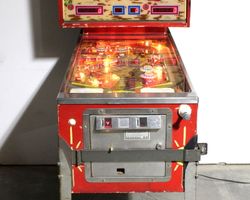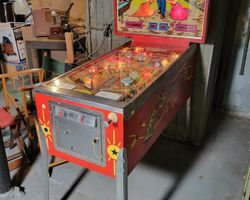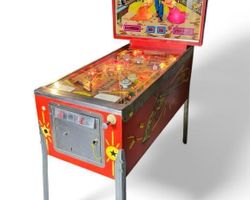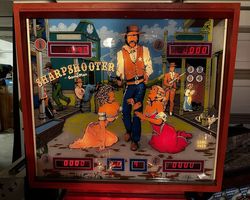Sharpshooter
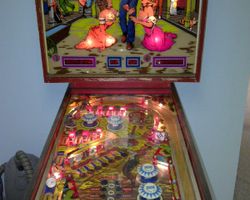
Average Prices: USD $100 to $1,000
Produced: May, 1979
Production Run: 4,200 units
Machine Type: Solid State Electronic
MPU: Game Plan MPU-2
Players: 4
Design by: Ed Cebula, Joe Joos Jr., Roger Sharpe
Art by: George Molentin
Mechanics by: Joe Joos Jr.
"Sharpshooter," a solid-state electronic pinball machine from Game Plan, Incorporated, emerged in May 1979 as a distinctive entry in the late 1970s pinball landscape. Manufactured by Game Plan, a company known for its unique designs during a relatively brief but impactful period in the industry, "Sharpshooter" quickly carved out its identity. The machine, bearing the model number 130, was produced in a confirmed run of 4,200 units, a respectable number for an independent manufacturer of the era. Its creation brought together a notable team: Ed Cebula and Joe Joos Jr. were instrumental in its design, with Roger Sharpe also contributing significantly to the machine's layout. The artistic vision for "Sharpshooter" was realized by George Molentin, while Joe Joos Jr. further handled the mechanical engineering. This collaboration resulted in a machine that embodied the spirit of the American West, a theme woven throughout its art and gameplay. A unique piece of trivia that endears "Sharpshooter" to many is the depiction on its backglass: the mustachioed cowboy is a caricature of designer Roger Sharpe himself, accompanied by his wife, Ellen, portrayed as the curly blonde figure. This personal touch from a prominent figure in pinball history adds an extra layer of narrative to the machine's origins, setting it apart from many of its contemporaries.
Signature Features and Design
"Sharpshooter" distinguishes itself with a combination of visual appeal and mechanical ingenuity. The Western theme is immediately apparent, anchoring the machine's aesthetic. George Molentin's artwork, while not universally lauded as a masterpiece, possesses a certain charm and thematic coherence that resonates with the machine's character. The backglass, in particular, with its personalized nod to Roger Sharpe and Ellen, serves as a captivating focal point, sparking conversation and connection. On the playfield, the visual design integrates with key mechanical features to enhance the overall experience. The placement and interaction of these elements are central to the machine's identity. Among its standout features are the significant 7-bank drop targets, which are critical to the game's scoring strategy and flow. Another hallmark is the unique arrangement of its four pop bumpers; two of these are positioned in a "double pop" configuration near the right flipper, creating a challenging and unpredictable rebound zone that demands quick reflexes. The inclusion of a spinning target and a kick-out hole further contribute to the dynamic playfield. These elements are not merely decorative but are integral to the gameplay, fostering a fast-paced, skill-driven experience that keeps players engaged.
Playfield and Mechanics
The "Sharpshooter" playfield presents a layout that is both challenging and strategically designed, reflecting the insights of Roger Sharpe. It features a deliberate arrangement of elements that encourages risky, high-reward shots, particularly in the lower half of the playfield. Central to the layout is the prominent 7-bank drop target array, often referred to as a "drop smasher" due to its pivotal role in the game. These targets are strategically placed to be integral to increasing bonus multipliers and overall scoring. The four pop bumpers are distributed to create active zones, but the pair situated near the right flipper, often described as "double pops," forms a particularly tricky area. Balls entering this zone can ricochet unpredictably, demanding precision and quick reactions to avoid immediate drains, yet also offering opportunities for unexpected shot setups.
Other interactive elements include a kick-out hole, crucial for advancing bonus multipliers, and a spinning target that adds a dynamic element to the upper playfield. Two standup targets and five star rollovers further contribute to the scoring opportunities and pathing options. A particularly notable and often discussed feature is the "50,000 point lane," a difficult but highly rewarding shot that players actively seek to master. Interestingly, the playfield omits a traditional right outlane, a design choice that some players find enhances the game's flow and reduces frustrating, unearned drains. The artwork on the playfield, in keeping with the Western theme, utilizes a color palette and stylistic elements that define the machine's era and Game Plan's visual identity, providing a clear and functional backdrop for the intense action.
Gameplay Dynamics
Gameplay on "Sharpshooter" is characterized by its fast pace and intense action, often concentrating around the flippers. The machine offers a continually challenging experience that rewards skill and accuracy over mere luck. While its rule set might appear straightforward initially, the depth for achieving high scores lies in mastering precise shots and understanding the flow of the playfield. The primary objective often revolves around clearing the 7-bank drop targets, which is fundamental to building score multipliers. Successfully clearing these targets not only awards points but also often opens pathways to other high-value shots or advances bonus sequences. The kick-out hole plays a crucial role in bonus progression, enticing players to aim for it to maximize their end-of-ball bonuses.
The "50,000 point lane" stands out as a high-stakes, high-reward shot that exemplifies the game's demanding nature. Successfully navigating the ball into this lane requires precision and timing, making it a celebrated achievement during gameplay. The unique "double pop bumpers" near the right flipper ensure that even stray shots can lead to unpredictable ball movement, requiring players to maintain focus and adapt quickly. Despite the apparent simplicity of its core objectives, the demanding layout and the emphasis on shot accuracy ensure that "Sharpshooter" remains engaging. New players can grasp the basic concepts quickly, but it truly takes a "sharp shooter" to consistently achieve top scores, making each game a test of a player's developing skill.
Reception and Legacy
"Sharpshooter" has cultivated a positive reputation within the pinball community, often celebrated as a "sleeper game" or a "best kept secret." Its value proposition is frequently highlighted, with many considering it an exceptional machine for its price point. Players consistently describe it as fun, challenging, and rewarding, believing it delivers an experience that surpasses expectations for a solid-state machine of its vintage. Its fast-paced action, combined with a demanding yet fair layout, is frequently cited as a major strength. Unique features like the strategically placed double pop bumpers and the high-value 50,000 point lane are particularly appreciated for adding distinctiveness and challenge. The machine is also often praised for its design and overall workmanship, reflecting well on Game Plan's capabilities despite their relatively short tenure in the industry. Many enthusiasts express regret that Game Plan did not continue producing machines, often viewing "Sharpshooter" as a testament to the company's design prowess.
However, the machine is not without its criticisms. Some players find that the gameplay can become repetitive after extended sessions, suggesting a simpler rule set compared to later, more complex designs. While the artwork generally serves its purpose and theme, it is not universally praised, with some opinions varying on its aesthetic appeal. Furthermore, while the sounds are often described as functional, some have characterized them as basic. From a maintenance perspective, the "Lego" connectors found in Game Plan machines can pose challenges for technicians. Despite these points, the overall sentiment remains overwhelmingly positive. "Sharpshooter" maintains its position as a noteworthy solid-state pinball machine, influencing later Game Plan titles like 'Sharp Shooter II' and cementing its place as a valued example of late 1970s pinball design. Its enduring appeal is a testament to its engaging gameplay and unique character.
Sponsored Links
 Ebay Listings
Ebay Listings
 Auction Results
Auction Results
| Cost | Location | Date |
|---|---|---|
| USD $450 |  Connecticut, United States Connecticut, United States |
29 March, 2025 |
| USD $450 |  Connecticut, United States Connecticut, United States |
29 March, 2025 |
| USD $425 |  Maryland, United States Maryland, United States |
27 February, 2025 |
| USD $300 |  Pennsylvania, United States Pennsylvania, United States |
10 November, 2024 |
| USD $300 |  United States United States |
30 September, 2024 |
| USD $2,497 |  California, United States California, United States |
23 June, 2023 |
| USD $1,600 |  Ohio, United States Ohio, United States |
12 November, 2022 |
| EUR €590 |  Bayern, Germany Bayern, Germany |
04 February, 2022 |
| USD $325 |  Texas, United States Texas, United States |
24 July, 2021 |
| USD $350 |  Texas, United States Texas, United States |
03 July, 2021 |


Private Policy · Search Website · Contact Us
As an eBay Partner, we may earn a commission from qualifying purchases made through links on this site, at no additional cost to you.
All trademarks and copyrighted materials remain property of their respective owners. All other content copyright 2007 - 2025 Pinpedia.

